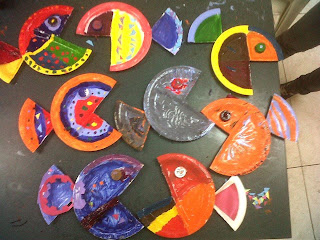 |
| Artistic crafts made by children with the support of the organization Be Free. |
The artistic essence of children is innate and through art it is possible to exercise the mental skills important for their school performance.
For children, art can be a means of communication that is as effective or even more effective than words, especially when their language is not yet developed. Through art, children are able to express their thoughts and feelings, which serves as a basis for them to express their creativity.
The visual arts include drawing, painting, modelling and sculpture. Music also plays a very important role in this area, if we consider that to a greater or lesser degree, every child is a born musician, singer and dancer.
The educational and recreational benefits of music and the arts in general extend to all children, regardless of whether or not they have any special artistic talent. In addition to teaching them about colors, shapes, textures, sounds, and the concepts of cause and effect, art encourages the representation of their experiences, the release of emotions, and the development of fine motor skills and visual-motor coordination.
Children's artistic expression changes according to their physical, mental and emotional growth.
The following are 20 reasons why it is important to introduce children to the arts from a young age:
- Art stimulates both sides of the brain and all areas of children's development—intellectual, social, emotional, motor, and language.
- Children are visual learners and music introduces children to the sounds and meanings of words.
- There are several scientific studies that show that children who do art read better and get better grades in math and science than those who were not encouraged in any artistic branch.
- Children learn using their senses and art is ideal in this process.
- Children need a place in school to express themselves and art is the best medium and resource for this. Children benefit from expressing their experiences, positive and negative, past and future, through art.
- Art promotes self-esteem and provides an opportunity for children to interact with others joyfully.
- Art encourages children to pay more attention to the physical space around them.
- Art develops coordination between the eyes and hands (visual-motor coordination).
- Art stimulates perceptual development. Music, for example, apart from teaching children how to listen to and appreciate melodies and rhythms, encourages memory development, the representation of events, the release of emotions and the development of motor skills required for singing, dancing or playing an instrument.
- Art teaches us to think by leaving open endings. It represents a culture of questions rather than a culture of answers.
- Art teaches that there can be more than one solution to a problem. Participating in artistic activities helps children to respect other ways of thinking, while giving them tools to solve their own problems and to communicate their thoughts and ideas in different ways.
- Art teaches children to think creatively to solve problems. It encourages creativity, innovation and curiosity.
- Children can share and reflect on their artwork and learn something about themselves and the world they live in.
- When art is integrated into other subjects in the school curriculum, children become more engaged in the learning process.
- In the process of making art, the child is exposed to different possibilities, to discovery, creation, innovation and freedom. In this way, falling into the control and predictability of conventional universalist education is avoided.
- Art nourishes the human soul. It feels good to do it. It gives pleasure and relaxation.
- Art brings the cultural resources of the community into the classroom. It strengthens the bond with the child's family and cultural roots.
- Art involves parents and guardians in the school by inviting them to participate as volunteers in various activities.
- Art provides a medium, a common ground, to overcome racial stereotypes, barriers and prejudices.
- Art is valuable in itself as it facilitates the expression of thoughts and feelings, and allows children to manifest their creativity, from a very young age and throughout their lives.
Adapted from: Sitiodebes.com
![]()
